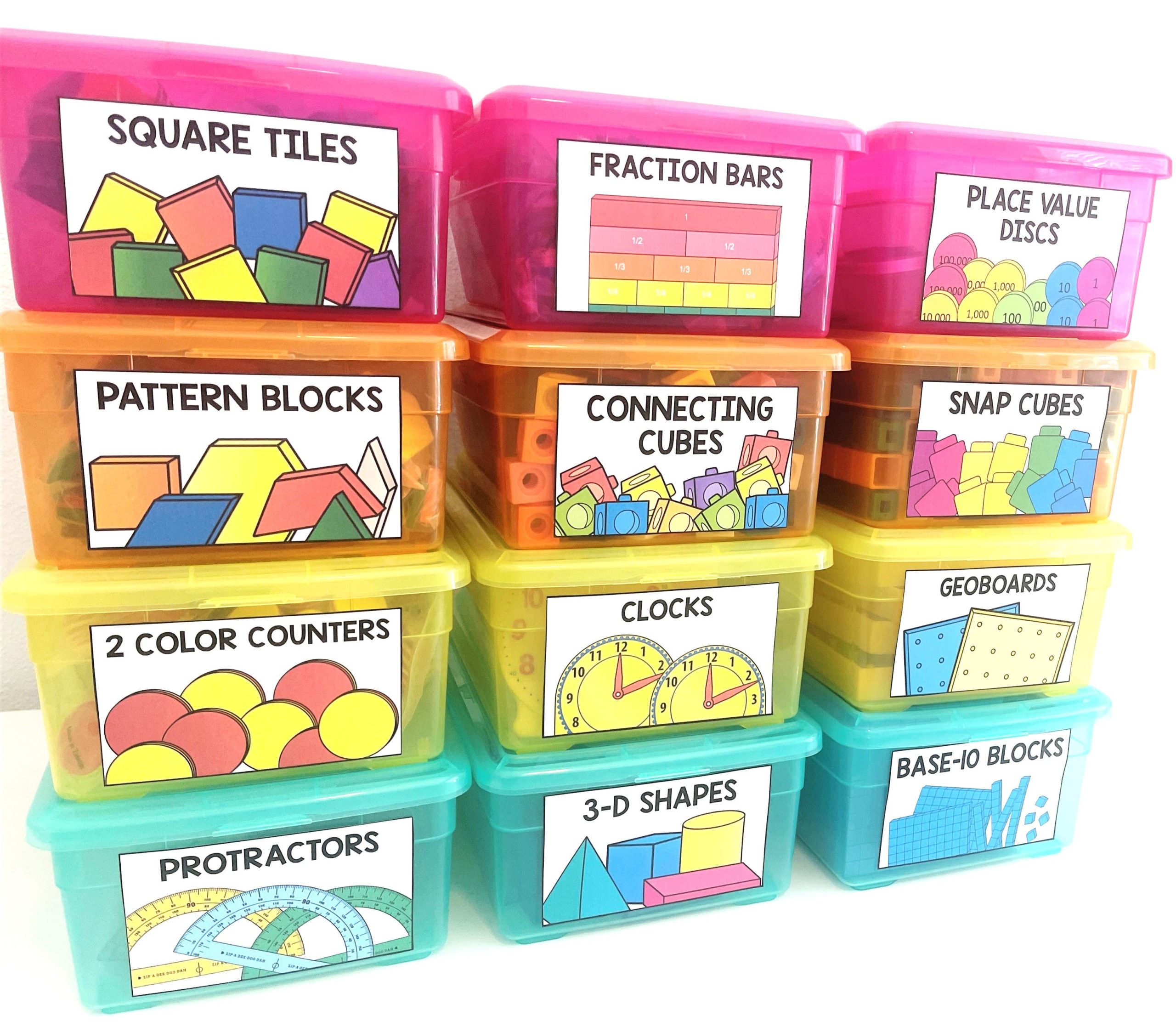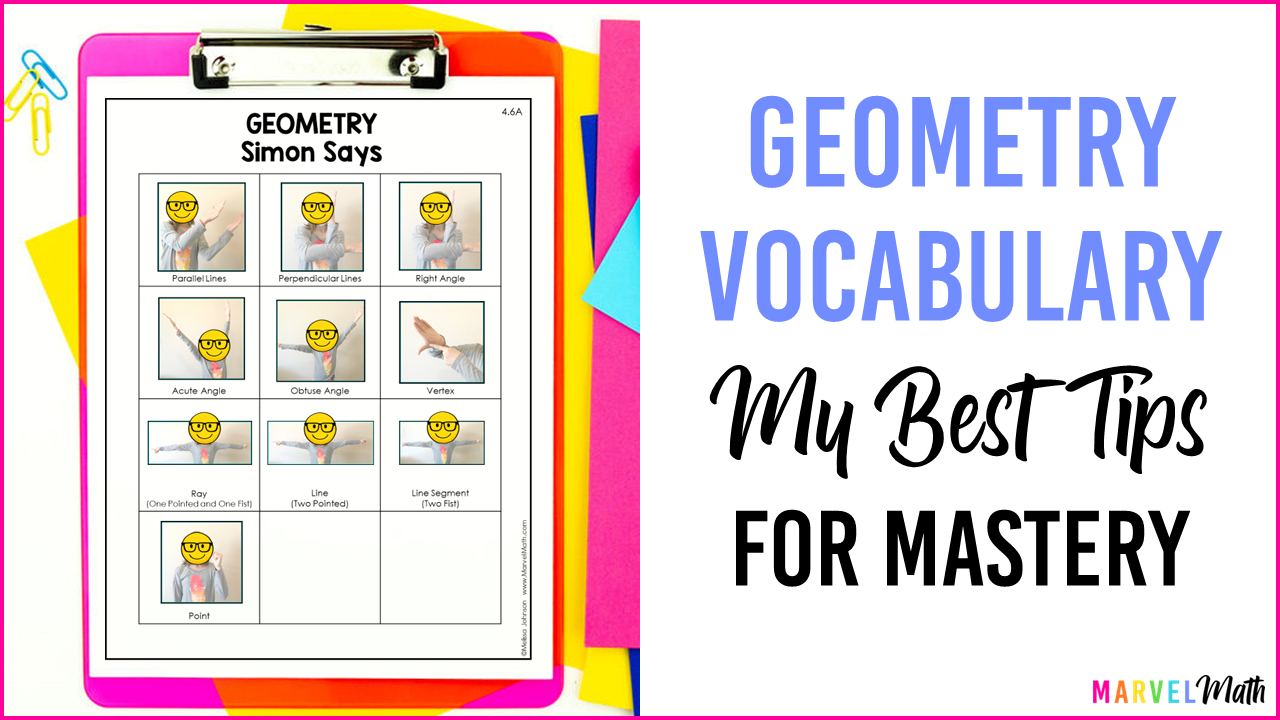
One of the most important parts of your Geometry Unit is teaching Geometry Vocabulary. A strong geometry vocabulary can be fun and easy for students to build and develop. I’ve put together some of my best tips for introducing and developing geometry vocabulary in your classroom. These exciting and simple methods to teach geometry vocabulary will ensure your students gain mastery over all the required geometry concepts.
How Do You Teach Vocabulary in Geometry?
Use geometry vocabulary activities that take students through their learning journey.
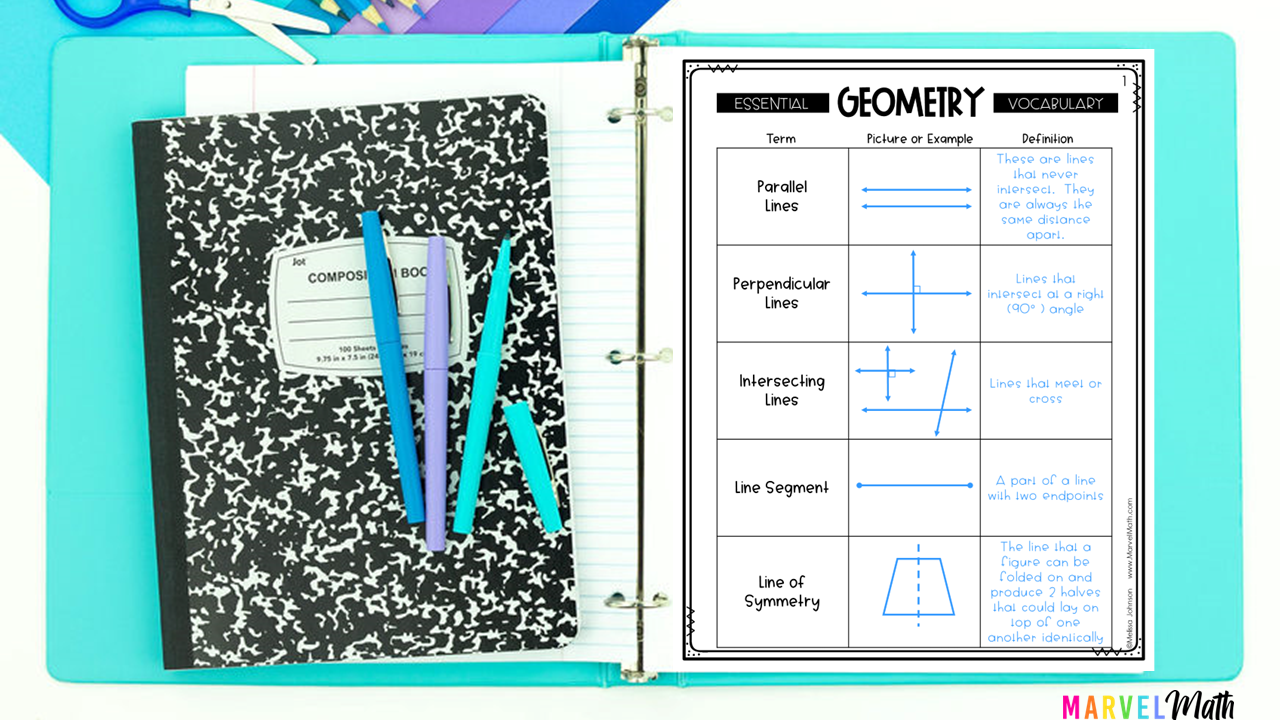
- Introducing Geometry Terms: Students should record definitions and pictures of geometry terms as they are introduced in a math journal. This reference tool should be open and easy for students to refer to during lessons and while they are at math stations.
- Practicing Geometry Terms: Students can practice new geometry terms as they learn them with fun games, art activities, and scavenger hunts.
- Using Geometry Terms in Context: Ultimately, students need to be fluent with geometry vocabulary terms to use them in context as they analyze 2D and 3D shapes.
Let’s talk about the very best ways to teach the essential terms your students need to know.
Surround Students with Illustrated Geometry Vocabulary Terms
Keep Geometry vocabulary posted on your walls all year long. Vocabulary terms should be accompanied by simple definitions and pictures. Students use words they remember. A word they learned once and hardly ever seen won’t be remembered. If you are running out of room inside your classroom, post it in the hallway or the wall near the restroom.
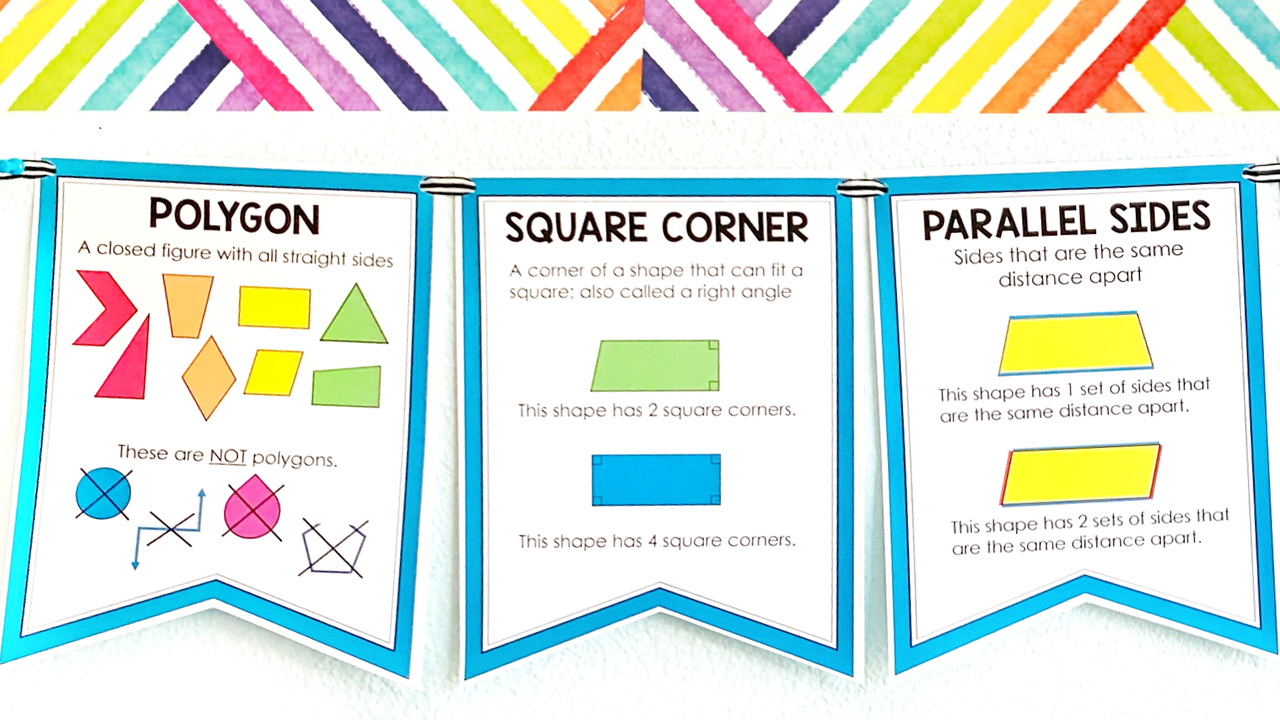
Start Early with a Geometry Vocabulary Word of the Week
It is nearly impossible for students to learn all the geometry vocabulary terms they need to know during your geometry unit. Ideally, work on vocabulary throughout your entire school year to build a foundation. Already in the thick of your unit? No worries, just jump in now and continue your weekly routine through the end of the year.
Introduce a new word each week. When you have gone through all of the words students need to learn for your grade level, rotate through them again. Post the word with an illustration and a definition each week.
As part of your morning routine, hand one student a 3 x 5 card with the vocabulary term for the week and ask them to find something that illustrates that term in your classroom and tape up the card by that object. For example, if the term is “acute angle” the student may tape the card on the wall near your flag, which likely has a flag pole that makes an acute angle with the wall above the flag pole. Have the student explain to the class what they labeled and how it illustrates the term.
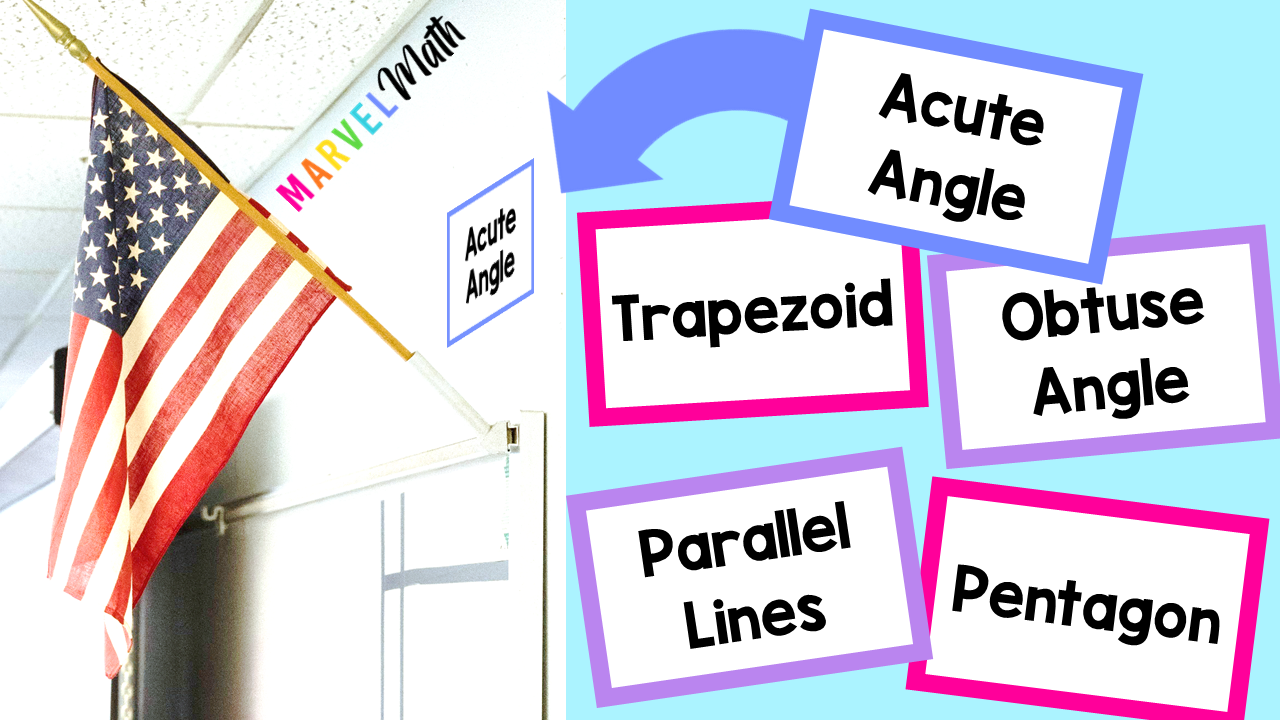
The next day, give another student a 3×5 card with the same vocabulary term and ask them to label something else in the room. You could have students label things in other parts of the school as well. Your students will suddenly be looking everywhere for objects that illustrate your geometry vocabulary term of the week, so that they are ready if you choose them the next morning.
Create Geometry Art
Geometric art is so much fun to create and helps students think about and apply key geometry vocabulary. Here is a simple activity that makes a perfect math station. All you need is paper, rulers, dice and markers, crayons or colored pencils.
Students will roll the dice to find what to draw. Encourage students to overlap what they are drawing to create interest in their art piece.
Example:
- Roll a 1 – Draw a line segment
- Roll a 2 – Draw parallel lines
- Roll a 3 – Draw an acute angle
- Roll a 4 – Draw perpendicular lines
- Roll a 5 – Draw a parallelogram
- Roll a 6 – Draw an obtuse angle
Students can roll the dice as many times as they like to build their art piece. I recommend around 10 rolls. When they are finished they can color in the piece to complete it. These geometry art creations make a great bulletin board display after they are finished!
Have a “Clue Style” Geometry Scavenger Hunt
This is a great activity to review lots of terms students have been introduced to. Make a list for students that names something to find in a specific room.
Give them a list at the start of the day using rooms they will visit that day in their regular schedule. I.e. Find an obtuse angle in the cafeteria, find a pentagon in the library, find parallel lines on the playground, find perpendicular lines in the hallway.
You can make this a purely verbal exercise and ask students after you pick them up from a certain location if they found something that illustrates the term they needed to find in that place.
Bonus points if an administrator is walking by and overhearing your students talk about where they saw perpendicular lines. It could instead be a math journal activity where students draw a picture when they are back in your classroom of the object that illustrates the word.
Play Geometry Vocabulary Games
Geometry vocabulary games are a great way to get students to use the terms they need to learn. Here are some of my favorite games.

Geometry Guess Who
This game is great to play as a whole class or in pairs at a math station. Give students a laminated page with pictures of shapes you are studying.
Have students ask yes or no questions like, “Does your shape have right angles?” If the answer is no, students can cross out all shapes with right angles. Students can continue to ask questions about shape attributes to eliminate shapes and find the correct shape.
Geometry I Spy
Have one student come to the front of the room and secretly pick an object in the room that displays a specific geometric term that you have given them, such as parallel lines. The student begins the game with “I spy something that has parallel lines.”
Students can ask more questions to narrow down the choices and then start guessing objects in the classroom that have parallel lines. Suddenly your students are seeing parallel lines everywhere. Play this game with any terms you need to practice. Here are some ideas:
- I spy something shaped like a rectangular prism.
- I spy something with an acute angle.
- I spy something that is a quadrilateral.
This is a great game to play whenever you have a few extra minutes.
Geometry Simon Says
Pick one student to be “Simon.” The student can give instructions like:
- Simon says make a right angle. (Students hold up their arms to make a right angle)
- Simon says make a line segment. (Students hold out both arms in a straight line and make fists with both hands)
- Simon says make perpendicular lines. (Students hold their arms to cross at a 90 degree angle)
The student playing “Simon” mixes in instructions without saying “Simon says.” If a student moves when the instructions don’t begin with “Simon says,” they are out for the rest of that round and they sit down. The last student standing becomes the new “Simon.”

Pick a Few Geometry Vocabulary Ideas to Use with Your Students
Geometry vocabulary doesn’t need to be daunting or overwhelming for students, it can be fun to learn. Try a few of these geometry vocabulary games and ideas to bring these important terms to life in your classroom. The best activities have students looking and searching for geometry in the world around them.
Have fun as you teach Geometry Vocabulary,

